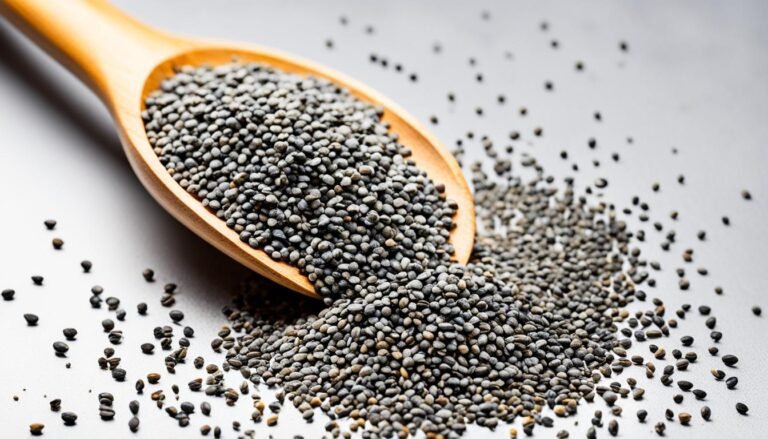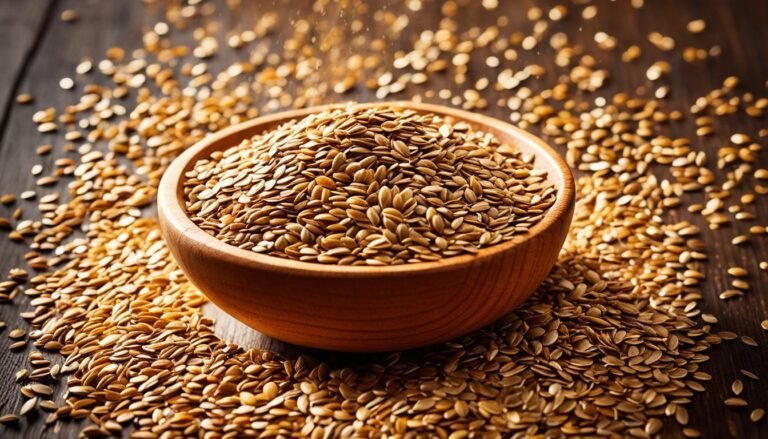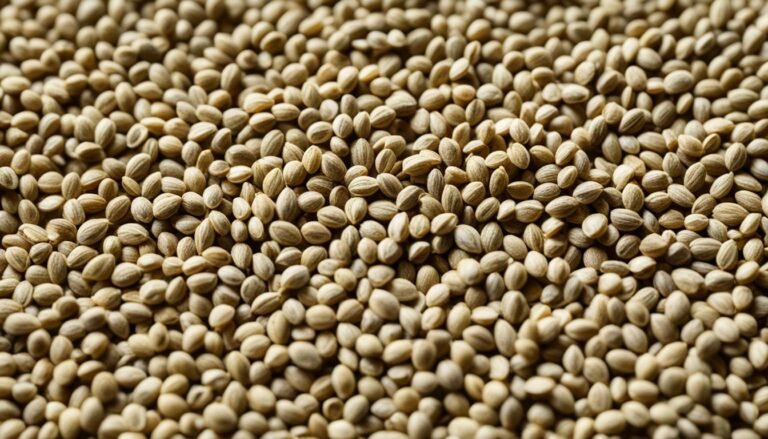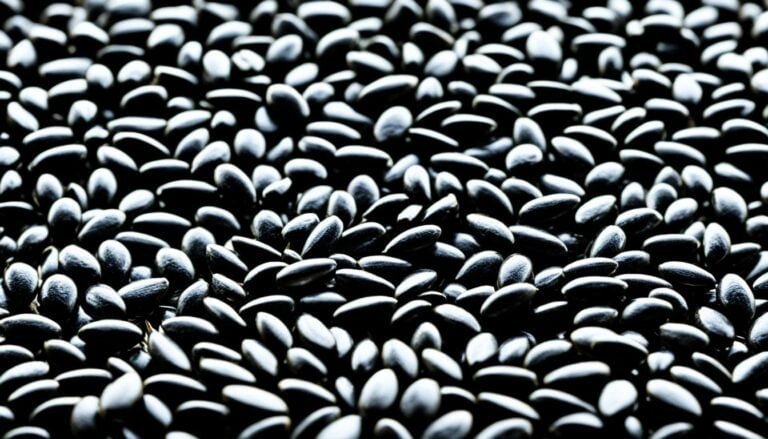Everything You Need to Know About Amaranth Seeds

Did you know amaranth, an ancient grain from the Americas, can produce up to 36.8 lbs of seeds and husks per 125 square feet? This superfood is gaining popularity, and for good reasons. Amaranth seeds are gluten-free and full of protein, fiber, and essential vitamins and minerals. If you’re looking to add variety to your diet or learn about its health benefits, this guide is for you.
Key Takeaways
- Amaranth is an ancient, nutrient-dense superfood that has been cultivated for thousands of years
- Amaranth seeds are naturally gluten-free and a great source of protein, fiber, and various micronutrients
- Amaranth can be used in a variety of dishes, from porridge to pancakes, and is a versatile ingredient in the kitchen
- Amaranth has a high calcium content, even more than traditional milk, and its nutrients are highly absorbable
- Amaranth is a sustainable and environmentally-friendly crop, making it a great addition to your pantry
Introduction
Amaranth is an ancient grain that has been around for over 8,000 years. It was a key food for the Inca, Maya, and Aztec people. This grain is special because it’s gluten-free and has many nutrients.
It belongs to the Amaranthaceae family and has over 60 different types. Each type has its own look and nutritional value. Amaranth is known for its bright flowers and nutritious seeds.
If you’re on a gluten-free diet or just want to try new foods, amaranth is great. It can be used in many dishes, from main courses to desserts. Exploring amaranth opens up a world of new tastes and health benefits.
“Amaranth is a highly nutritious and versatile ancient grain that has been celebrated for its exceptional health benefits and culinary versatility.”
Health Benefits of Amaranth Seeds
Amaranth is a superfood packed with nutrients. It’s a great source of fiber, protein, and important vitamins and minerals. These nutrients support your health. Let’s look at how adding amaranth seeds to your diet can benefit you.
Amaranth is packed with protein, even more than grains like corn or rice. This makes it perfect for vegetarians, vegans, and anyone wanting more plant-based protein.
It’s also full of fiber, which is key for a healthy gut. Fiber helps with digestion, keeps your gut healthy, and can help with weight control by making you feel full.
Amaranth is a powerhouse of micronutrients. One cup of cooked amaranth gives you over 100% of the daily manganese you need. It also has lots of magnesium, phosphorus, iron, and selenium.
Amaranth is full of antioxidants like phenolic acids. These can protect your body from oxidative stress. This might lower the risk of heart disease and cancer.
Studies also show that amaranth may fight inflammation and help lower cholesterol. More research is needed, but the early signs are promising.
With its rich nutrient profile, amaranth is a great choice for a healthy diet. Add it to your meals, snacks, or baked goods. It can boost your health and well-being.
Nutritional Composition of Amaranth Seeds
Amaranth is a nutrient-packed ancient grain. It has a great nutritional profile. One cup of cooked amaranth has 251 calories, 9.3 grams of protein, 46 grams of carbs, and 5.2 grams of fiber. This grain is gluten-free and a top source of manganese, giving you 105% of what you need daily.
It also has a lot of magnesium (40% of the RDI), phosphorus (36% of the RDI), and iron (29% of the RDI).
Apart from these minerals, amaranth seeds have selenium, copper, and other key nutrients. With protein, fiber, and important vitamins and minerals, amaranth is a nutritious and balanced ancient grain.
| Nutrient | Amount per Cup (246g) | % Daily Value |
|---|---|---|
| Protein | 9.3g | 19% |
| Fiber | 5.2g | 21% |
| Manganese | 2.1mg | 105% |
| Magnesium | 160mg | 40% |
| Phosphorus | 364mg | 36% |
| Iron | 5.2mg | 29% |
These nutritional facts show why amaranth is great for a healthy diet. It’s perfect for boosting your nutrient intake or trying out ancient grains. Amaranth is a top choice for anyone looking to eat better.
Amaranth Seeds and Weight Management
Amaranth is a nutritious seed that’s becoming popular for weight loss. It’s full of fiber and protein, which helps you feel full, build muscle, and boost your metabolism. This makes it great for managing weight.
Studies show that eating amaranth can help reduce body fat and improve metabolic health. It has important amino acids, iron, magnesium, and more. These nutrients support a healthy metabolism and weight.
Amaranth also has a low glycemic index, which keeps your blood sugar stable. This can prevent weight gain. Plus, its antioxidants fight oxidative stress, which helps with weight loss.
The fibers in amaranth help control fat absorption and keep your gut healthy. This is key for managing weight. You can use amaranth instead of rice or pasta, or add it to soups, salads, or baked goods.
Try it in porridge with cinnamon and berries, salads with veggies and beans, or stuffed peppers with veggies and lean protein.
| Nutrient | Amount per 100g |
|---|---|
| Calories | 371 Kcal |
| Dietary Fiber | 7 g |
| Protein | 14 g |
| Calcium | 159 mg |
| Iron | 7.6 mg |
Amaranth seeds have been eaten by the Aztecs for over 8,000 years. They’re gluten-free and great for those with gluten sensitivities. They also have phytosterols to help with cholesterol and heart health, and anti-inflammatory components to fight inflammation and prevent diseases.
If you want to lose weight, improve your health, or just eat healthier, adding amaranth seeds to your diet is a smart move.
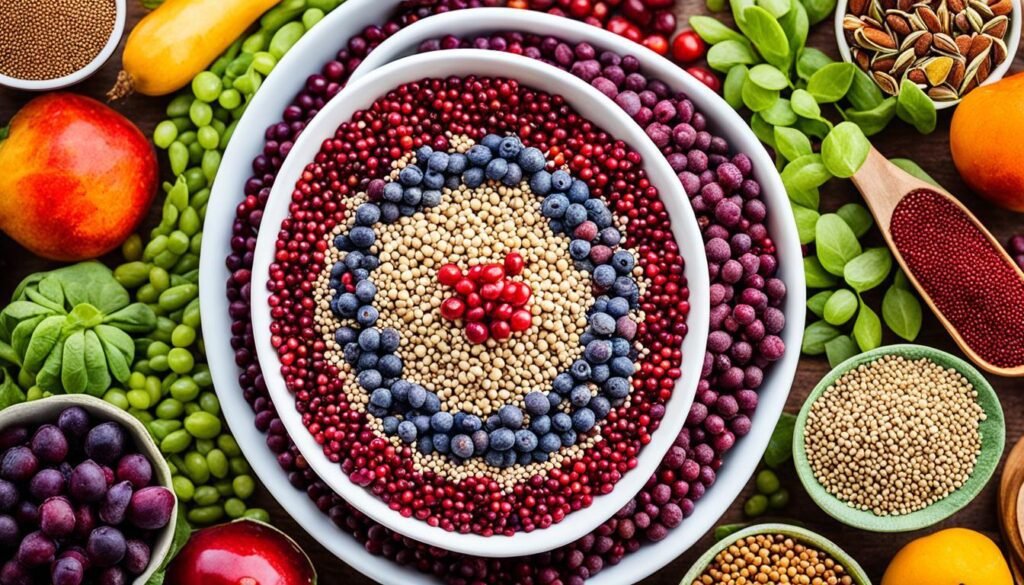
Antioxidant Properties of Amaranth Seeds
Amaranth seeds are packed with health-boosting antioxidants. They are full of phenolic acids like gallic acid, p-hydroxybenzoic acid, and vanillic acid. These acids are great at fighting free radicals, which can cause chronic diseases.
Research shows amaranth is loaded with these antioxidants. Studies on animals show it boosts antioxidant enzymes and protects the liver from damage. While we need more human studies, the current findings suggest amaranth seeds could be very beneficial for health.
| Antioxidant Compound | Concentration in Amaranth Seeds |
|---|---|
| Gallic Acid | High |
| p-Hydroxybenzoic Acid | High |
| Vanillic Acid | High |
| Vitamin C | 420 ppm |
| Vitamin A | 250 ppm |
Amaranth seeds are full of antioxidants thanks to their phenolic compounds and vitamins. These antioxidants fight free radicals, lowering oxidative stress and inflammation. Adding amaranth to your meals can help you enjoy its amazing antioxidant benefits.
“Amaranth is especially high in beneficial phenolic antioxidants that can help protect the body against the damaging effects of free radicals.”
Amaranth seeds are also rich in protein, fiber, minerals, and vitamins. Using this superfood can improve your health in many ways. Try adding amaranth to your diet to see its amazing effects.
Different Varieties of Amaranth
Amaranth is a versatile and diverse ancient grain, with over 60 species. It comes in a wide array of colors, flavors, and uses. From deep reds and purples to vibrant greens, its look is as stunning as its health benefits.
The most common types grown for their grains are Amaranthus caudatus, Amaranthus cruentus, and Amaranthus hypochondriacus. These varieties are great for making porridges, breads, snacks, and desserts.
There are also leafy green amaranths that are eaten for their nutrients. These greens add flavor and vitamins to salads, soups, and more.
| Amaranth Variety | Color | Primary Use |
|---|---|---|
| Amaranthus caudatus | Red, purple | Grain |
| Amaranthus cruentus | Gold, orange | Grain |
| Amaranthus hypochondriacus | Green, red | Grain |
| Amaranthus tricolor | Green, purple, red | Greens |
| Amaranthus dubius | Green | Greens |
With so many amaranth varieties, there’s endless creativity in the kitchen. It lets us explore the rich history and cultural importance of this superfood.
“Amaranth is a true superfood, not only for its exceptional nutritional profile but also for its versatility in the kitchen. From vibrant greens to golden grains, this ancient grain offers a world of culinary possibilities.”
Comparing Amaranth Seeds to Other Ancient Grains
Amaranth is often compared to other grains like quinoa, millet, sorghum, and teff. These grains are all nutrient-dense and gluten-free. Each grain has its own special qualities that make it great for a healthy diet.
Quinoa is well-known for its high protein and fiber, similar to amaranth. Amaranth has 4.7g of protein per ½ cup, more than brown rice and as much as quinoa. It also has 2.6g of fiber, more than brown rice and equal to quinoa.
Millet is a small grain packed with B vitamins and minerals. Sorghum is drought-resistant and can be popped like popcorn. Teff is tiny but a key food in Ethiopia. Each grain brings its own nutrients and ways to cook, giving people many whole grain choices.
| Nutrient | Amaranth | Quinoa | Millet | Sorghum | Teff |
|---|---|---|---|---|---|
| Protein (per ½ cup cooked) | 4.7g | 4.0g | 2.8g | 3.5g | 3.1g |
| Dietary Fiber (per ½ cup cooked) | 2.6g | 2.6g | 2.2g | 1.9g | 2.8g |
| Iron (per ½ cup cooked) | 2.6mg | 1.4mg | 0.8mg | 0.5mg | 1.5mg |
| Magnesium (per ½ cup cooked) | 80mg | 64mg | 46mg | 55mg | 69mg |
| Calcium (per ½ cup cooked) | 58mg | 36mg | 6mg | 12mg | 57mg |
Amaranth and quinoa are similar but also different. Amaranth stands out for its high protein, fiber, iron, magnesium, and calcium. Adding different ancient grains to your diet gives you a wide range of nutrients for good health.
Choosing amaranth, quinoa, millet, sorghum, or teff means you’re picking a gluten-free ancient grain. These grains add flavor and nutrition to your meals.
Amaranth Seeds in Cooking
Amaranth is a versatile ancient grain that can be used in many tasty recipes. Before cooking, sprout the amaranth seeds to make them easier to digest and more nutritious. To cook amaranth, simmer it in a 3:1 water-to-grain ratio until the liquid is gone, which usually takes about 20 minutes.
Cooked amaranth can be added to smoothies, used as a pasta or rice substitute, or mixed into soups and stews. It also makes a great breakfast cereal. The nutty, earthy taste of amaranth is perfect in salads, baked goods, and snacks. Here are some popular recipes that show off the versatility of amaranth seeds.
Recipes Using Amaranth Seeds
- Amaranth Porridge: Start your day with a hearty bowl of amaranth porridge. Simmer it with milk or plant-based milk. Top it with fresh fruit, nuts, and a bit of honey.
- Amaranth and Veggie Stir-Fry: Sauté amaranth seeds with your favorite veggies like bell peppers, onions, and leafy greens. It makes a gluten-free, nutrient-rich stir-fry.
- Amaranth Energy Bars: Blend amaranth seeds with nuts, seeds, dried fruit, and a little sweetener. You get homemade, protein-rich energy bars.
- Popped Amaranth Snacks: Pop amaranth seeds on the stovetop like popcorn. Then, season them for a crunchy, healthy snack.
Amaranth’s versatility lets it fit into many amaranth recipes and cooking with amaranth ideas, from breakfast to snacks. Its unique taste and nutritional benefits make it a great addition to your cooking.
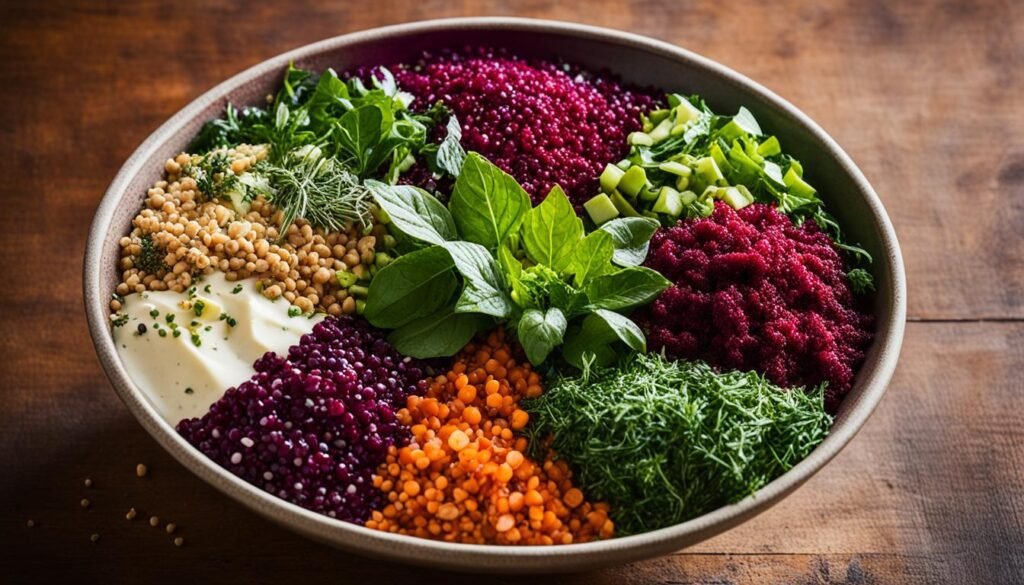
Amaranth Flour: Benefits and Uses
Ancient grain amaranth can be ground into flour that’s packed with nutrients. It’s gluten-free, making it great for those avoiding gluten. You can use it to make gluten-free bread, tortillas, pancakes, and more.
Traditional Dishes with Amaranth
Amaranth flour has been a key ingredient in many traditional dishes for centuries. In Ethiopia, it’s used to make kita, an unleavened bread. In India, it goes into laddoos, a sweet dessert.
In Mexico, amaranth flour is used for tlayudas, big tortillas with toppings, and alegrias, candies from popped seeds. Its versatility lets it fit into many cuisines.
Amaranth flour is not just a gluten-free option; it’s also packed with protein, fiber, and vitamins. It can help lower cholesterol, control blood pressure, and might even protect against some cancers thanks to its antioxidants.
When baking with amaranth flour, mix it with other gluten-free flours like almond flour. This mix balances its strong taste and lack of gluten. Together, they make tasty, nutritious baked goods for many diets.
“Amaranth flour is a game-changer for gluten-free baking, offering a nutrient-dense and versatile alternative to traditional wheat flour.”
Exploring amaranth flour is a great way to try new gluten-free recipes or add ancient grains to your meals. Its history, cultural importance, and health benefits make it a top choice for any kitchen.
Growing Amaranth
Amaranth is a great crop for home gardens. It gives you a tasty grain, healthy leaves, and bright flowers. This plant loves the sun and takes about 90-100 days to grow fully. It’s perfect for both new and experienced gardeners.
Start amaranth seeds indoors 4-6 weeks before the last spring frost. Move the seedlings outside, keeping them 12 inches apart in rows 15 inches apart. This lets the plants grow big, filling the space as they go.
Amaranth needs rich, well-draining soil and 6 hours of sunlight daily. Water it about 1 inch a week, adjusting as your climate demands. In summer, the plants bloom with red or golden flowers that you can dry for decorations.
To harvest the seeds, cut the seed heads when they’re dry. Then, separate the seeds from the husks with a gentle winnowing process. Growing amaranth is a bit more work than veggies, but it’s rewarding and gives you a lot of this healthy grain.
| Amaranth Cultivation Details | Specifications |
|---|---|
| Soil Temperature for Germination | Minimum 50°F, optimal 68°F and above |
| Planting Spacing | 12 inches between plants, 15 inches between rows |
| Mature Plant Height | 2-6 feet tall |
| Bloom Time | Mid-summer to first frost |
| Flower Color | Red, golden, or multicolored |
| Hardiness Zones | 2-11 (USDA) |
By following these steps, you can grow your own amaranth at home. Enjoy its many benefits from leaves to seeds. It’s a great choice for any sustainable garden, whether you’re a pro or a beginner.

Environmental Impact of Amaranth Farming
Amaranth is a top choice for eco-friendly farming. It uses low water and is drought-tolerant. This makes it perfect for areas with climate resilience issues.
It uses much less water than crops like wheat or corn. This helps save precious water. Amaranth can grow well even with little rain, making it great for sustainable amaranth farming.
Amaranth also improves poor soil and helps soil health with its deep roots. This is key for sustainable farming, especially with climate change and soil problems.
Even though it doesn’t produce as much as some grains, amaranth’s benefits are huge. It’s vital for eco-friendly food production. With water scarcity and climate change, amaranth farming is a bright spot for the future.
| Crop | Water Requirement | Drought Tolerance | Soil Improvement |
|---|---|---|---|
| Amaranth | Low | High | Yes |
| Wheat | High | Low | No |
| Corn | High | Moderate | No |
Amaranth’s benefits for the environment and its ability to handle climate change make it a top crop for sustainable farming. Its low water needs and soil improvement make it a great choice for food production in tough conditions.
Organic vs. Non-Organic Amaranth
When choosing amaranth, you can pick between organic and conventional types. Both have the same nutrients, but picking organic affects the environment and your health.
Organic amaranth grows without synthetic pesticides, herbicides, or fertilizers. This makes it a better choice for the planet. It follows sustainable farming and keeps the product pure. On the other hand, conventional amaranth might use chemicals, which could leave residues on the product.
For those who care about health and the planet, choosing organic amaranth is wise. It supports eco-friendly farming and gives you peace of mind. More people are picking organic over conventional amaranth for these reasons.
“Amaranth is considered a versatile and nutritious grain, commonly used in dishes like porridges, granolas, pancakes, and breads.”
Most amaranth in the U.S. comes from small farms in the Himalayas and is likely organic. These organic amaranth grains grow without synthetic chemicals. They are a top choice for those wanting a clean and sustainable product.
Whether you go for organic or conventional amaranth, both are nutritious and can fit into a healthy diet. But if you value the environment and chemical-free products, organic amaranth is the better choice.
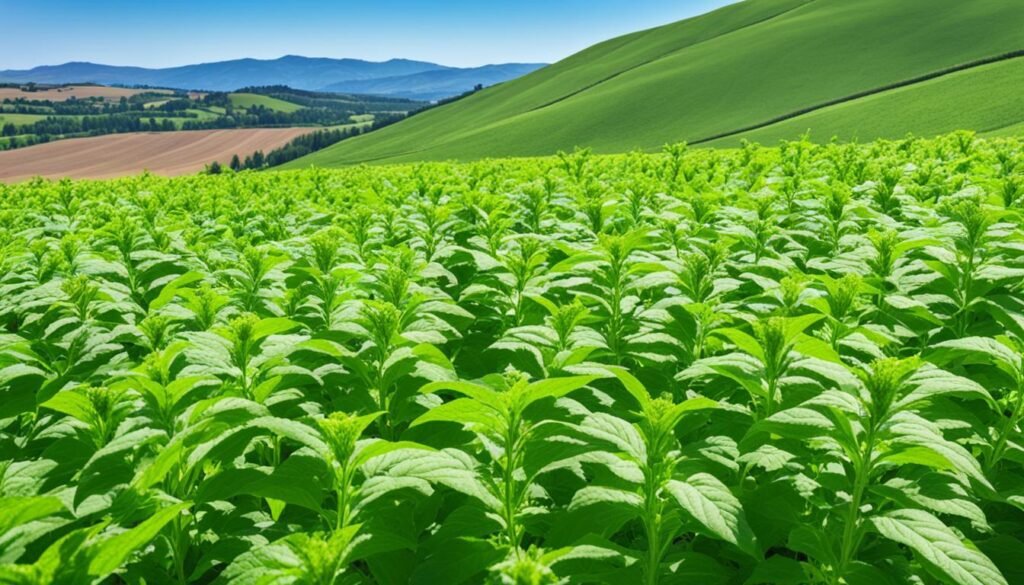
History of Amaranth
Amaranth has a long and interesting history that goes back thousands of years. It was a key food for the Inca, Maya, and Aztec people in Central and South America. These cultures saw amaranth as vital for their health and used it in their religious and cultural events.
Studies show that people have grown amaranth for over 8,000 years, with the first records from northern Argentina. The first type, A. cruentus, was grown about 6,000 years ago. Archaeologists have found amaranth seeds in many places, showing its long history in the Americas.
Over time, amaranth became even more important. It was one of the top three crops the Aztec Empire took as taxes from its provinces in the 15th and 16th centuries. This shows how much value amaranth had to these ancient people.
But, the Spanish conquest changed everything for amaranth. The Spanish saw its use in religious and cultural events as wrong and banned it. This made people stop growing and eating amaranth for many years.
Now, amaranth is making a big comeback. Its great nutrition and many uses in cooking have made people love it again. Today, it’s grown in many places around the world. It still plays a big role in the food and culture of its original places in the Americas.
“Amaranth was a staple dish for civilizations such as the Incas, Mayas, and Aztecs in South America.”
The story of amaranth is one of coming back strong. It shows how this amazing grain has touched the lives and fed the bodies of people over many generations and cultures.
Cultural Importance of Amaranth
Amaranth is very important in many cultures, especially in the Americas. It has been grown for thousands of years. This grain is a key part of traditional foods, spiritual beliefs, and the identity of indigenous peoples.
In Ethiopia, people make a special bread called kita and a drink called borde with amaranth. In India, it’s mixed with rice and used in laddoos, a sweet dessert. The Vietnamese use its greens in salads and soups.
In Mexico, amaranth flour makes tlayudas, big tortillas, and the seeds are turned into alegrias, a sweet candy. These foods have been enjoyed since Aztec times.
Amaranth has also played a big role in spiritual ceremonies. The Aztecs used it to honor their war god, Huītzilōpōchtli. But, the Spanish banned it in the 1500s, seeing it as a threat to Christianity. Yet, indigenous farmers kept it alive, saving its seeds.
Now, amaranth is sold as a health food and is in energy bars. But, it’s still not a big part of modern diets. It’s still very important in rural indigenous communities. There, it’s a main food and a key part of their traditions and beliefs.
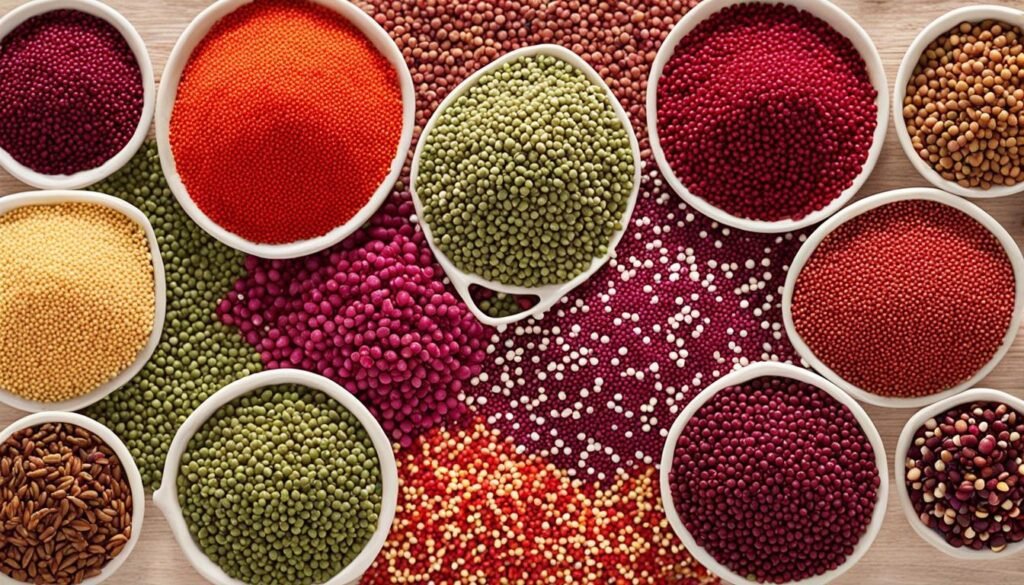
Amaranth is a key food for Indigenous people from Guatemala to the American Southwest. It gives them important proteins and amino acids. The first people in the Americas picked and domesticated amaranth, keeping it alive through hard times.
“The seeds for the amaranth growing in the Botanical Garden were sourced from an Indigenous woman named Elena in Guatemala.”
Even with challenges, amaranth’s importance stays strong. Groups like Qachuu Aloom in Guatemala work to keep its traditions alive. They offer seed banks, nutrition classes, and more. These efforts help keep amaranth a part of both food and culture for the future.
Amaranth Seeds for Skin and Hair
Amaranth is an ancient superfood that’s good for your skin and hair. It’s packed with protein, antioxidants, and nutrients. These make it great for natural beauty products.
Amaranth oil is great for skincare. It’s full of essential fatty acids that hydrate the skin well. It also has squalene, an antioxidant that fights fine lines and wrinkles.
It’s perfect for dry, sensitive, or mature skin. It helps with skin regeneration and treats psoriasis and acne. It also makes skin more elastic and radiant.
Amaranth for Stronger, Healthier Hair
Amaranth’s nutrients like protein, lysine, and squalene are good for your hair. Lysine makes hair strong and helps it grow. Squalene keeps hair moisturized, shiny, and prevents breakage.
Using amaranth-based hair products can make your hair healthier and more vibrant. It’s a natural way to improve your hair’s health and look.
Looking to improve your skin or hair? Amaranth seeds are a natural and effective choice. Try using this ancient superfood in your beauty routine for a glowing and healthy look.
Managing Allergies to Amaranth Seeds
Amaranth is usually safe and okay for most people to eat. But, some might have allergic reactions. People with celiac disease or gluten sensitivity are usually fine with amaranth. Yet, a few might be allergic to the proteins in amaranth seeds.
If you’re allergic to amaranth, you might feel sick to your stomach, get a rash, or have trouble breathing. These symptoms can make you feel really bad.
If you react badly to amaranth, stop eating it and talk to a doctor. They can figure out what to do next. Tests like skin prick tests and blood tests can check if you’re allergic to amaranth. Keeping track of what you eat can also help spot any patterns of allergic reactions.
People with amaranth allergies can still enjoy other gluten-free grains. It’s important to see an allergist for the right diagnosis and treatment plan.
Some people with an amaranth allergy might also react to quinoa and buckwheat. And if you’re allergic to latex, be careful with amaranth too.
It’s key to avoid foods with amaranth and check labels carefully. For mild allergies, antihistamines can help. But for severe reactions, you might need an epinephrine auto-injector. Sometimes, immunotherapy can help you get used to it over time.
Being careful is important to avoid accidental exposure to amaranth. This is especially true because of the risk of cross-contamination in food processing. By knowing how to handle amaranth allergies, you can still enjoy the health benefits of this grain.

Amaranth in Ayurveda and Traditional Medicine
Amaranth has a long history in Ayurvedic and traditional medicine. In Ayurveda, it’s seen as a nutritious and versatile grain. It’s said to balance the body’s doshas and support health.
Ayurvedic medicine uses amaranth for many conditions, like anemia and skin issues. It’s packed with protein, calcium, iron, magnesium, and antioxidants. This makes it a key ingredient in traditional remedies.
Modern science is still learning about amaranth’s health benefits. But its long use in traditional medicine shows it’s good for overall health. It can boost the immune system, improve digestion, and help with skin health.
“Amaranth is considered a highly nutritious and versatile grain with a range of therapeutic properties in Ayurveda, the ancient Indian system of medicine.”
In Ayurveda, amaranth tastes sweet and astringent. It’s good for kapha and pitta doshas. This makes it a great addition to a balanced diet.
Amaranth in Ayurvedic Remedies
- Amaranth treats health issues like anemia and skin problems in Ayurvedic medicine.
- Its seeds and leaves are used in remedies for their health benefits.
- Practitioners suggest amaranth to balance the doshas and improve well-being.
The scientific community is still studying amaranth’s benefits. But its long use in traditional medicine shows it’s a valuable food. By learning about amaranth, people can add it to their diets and wellness routines.
Popular Amaranth Seed Products
Amaranth seeds are found in many products, showing how versatile this ancient superfood is. Amaranth flour is a gluten-free option for baking. It’s used to make nutritious breads, tortillas, and other treats.
Popped amaranth is a popular snack because it’s crunchy and packed with nutrients. You can enjoy it alone or add it to granola, cereals, and energy bars. It boosts your intake of protein, fiber, and vitamins and minerals.
Amaranth oil is used in skincare for its moisturizing and antioxidant properties. It’s full of fatty acids like linoleic acid and squalene. These can help keep your skin healthy and glowing.
Amaranth seeds are also in breakfast cereals, nutrition bars, and other foods. This makes it easy for people to get its nutritional benefits. Amaranth fits well into many products, making it easy for health-conscious consumers to find.
| Amaranth Seed Product | Price Range | Rating | Variants |
|---|---|---|---|
| Amaranth Flour | $4.35 – $16.99 | Rated 5.00 out of 5 | Organic, Gluten-Free |
| Popped Amaranth | $5.99 – $12.95 | Rated 4.50 out of 5 | Plain, Flavored |
| Amaranth Oil | $12.99 – $168.00 | Rated 3.00 out of 5 | Unrefined, Refined |
Amaranth has a long history, dating back nearly 8,000 years. It was once widely farmed in ancient Mexico, Guatemala, and Peru. Now, it’s gaining popularity in countries like India, China, Nepal, and parts of Africa.
If you want to add amaranth to your diet, baking, snacking, or skincare, there are many quality products to choose from. Check out the wide range of amaranth seed-based products. Discover how this ancient superfood can improve your health and wellness.
Buying and Storing Amaranth Seeds
You can buy amaranth seeds in many places. Look for them in regular grocery stores, natural food markets, and online. These seeds are getting more popular, so they’re easy to find. Just make sure to check they are fresh and of good quality.
After buying amaranth seeds, it’s important to store them right. They can last about four months in an open container in your pantry. This is a bit less than wheat, which lasts six months. To keep your amaranth seeds fresh, put them in an airtight container in a cool, dark spot. This keeps their protein, fiber, vitamins, and minerals safe.
Amaranth is a versatile and easy-to-grow ancient grain. It’s great for cooking or growing yourself. With proper care in buying and storing, you can enjoy amaranth’s health benefits for a long time.
FAQ
What is amaranth and where does it come from?
Amaranth is an ancient grain from the Americas. It’s now grown worldwide, including in China, India, and Africa. Most U.S. amaranth comes from small farms in the Himalayas and is often organic.
What are the health benefits of amaranth seeds?
Amaranth is packed with protein, fiber, and essential nutrients like manganese and iron. It’s also full of antioxidants, which can help fight heart disease and cancer.
What is the nutritional profile of amaranth seeds?
One cup of cooked amaranth has 251 calories, 9.3 grams of protein, and 46 grams of carbs. It’s a great source of manganese, magnesium, phosphorus, and iron.
How can amaranth seeds help with weight management?
Amaranth’s high protein and fiber can aid in weight control. High-protein diets reduce hunger and calorie intake. The fiber makes you feel full longer.
What are the antioxidant properties of amaranth seeds?
Amaranth seeds are rich in antioxidants like phenolic acids. These compounds protect the body from harmful free radicals, reducing the risk of chronic diseases.
What are the different varieties of amaranth?
There are over 60 amaranth species, including red, purple, gold, and green varieties. Common types for grain include Amaranthus caudatus and Amaranthus hypochondriacus.
How does amaranth compare to other ancient grains?
Amaranth is often compared to quinoa and other ancient grains. While similar in being gluten-free and nutritious, each grain has unique nutritional profiles and uses.
How can I use amaranth seeds in cooking?
Use amaranth seeds in porridges, stir-fries, baked goods, and snacks. You can cook them whole, sprout them, or grind into flour for gluten-free baking.
What are some traditional dishes made with amaranth?
Traditional dishes include Ethiopian kita bread, Indian laddoos, and Mexican tlayudas. Amaranth flour is used in these and other global recipes.
How can I grow amaranth at home?
Amaranth grows in warm weather and takes about 90-100 days to mature. Start seeds indoors and transplant them outside after the last frost. Space them 12 inches apart.
What are the environmental benefits of amaranth farming?
What’s the difference between organic and non-organic amaranth?
Organic amaranth is grown without synthetic pesticides or fertilizers. It’s a sustainable choice compared to non-organic amaranth, which may use these chemicals.
What is the history and cultural significance of amaranth?
Amaranth was a staple in ancient Inca, Maya, and Aztec diets. It’s still important in many cultures, used in traditional dishes and ceremonies.
Can amaranth seeds benefit skin and hair health?
Yes, amaranth’s protein and antioxidants can improve skin and hair health. Amaranth oil is sometimes used in skincare for its moisturizing effects.
Can amaranth cause allergic reactions?
Amaranth is usually safe, but some people may be allergic to it. This can cause digestive or skin issues, or breathing problems.
How is amaranth used in Ayurvedic and traditional medicine?
What amaranth seed products are available?
Where can I buy amaranth seeds and how should I store them?
Look for amaranth seeds in grocery stores, natural food shops, or online. Choose organic options when possible. Store them in a cool, dry place in an airtight container for up to 2 years.

